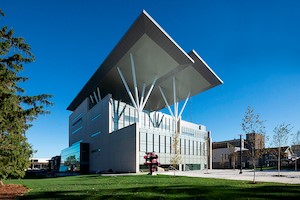CaGBC recommends government prioritize post-pandemic green building
According to the Canada Green Building Council (CaGBC) the COVID-19 pandemic is the perfect opportunity to invest in construction projects and training initiatives that support green construction.
 With infrastructure expected to play a key role in the country’s economic recovery during and after the pandemic, the council says that now is the time to consider investing in zero-carbon and low-carbon buildings that can help Canada meet its climate goal of reducing emissions to 30 percent below 2005 levels by 2030.
With infrastructure expected to play a key role in the country’s economic recovery during and after the pandemic, the council says that now is the time to consider investing in zero-carbon and low-carbon buildings that can help Canada meet its climate goal of reducing emissions to 30 percent below 2005 levels by 2030.
“The decisions the government makes now could set a new course that can benefit Canadians for the next 10, 20, 50 or even 100 years,” says the council in its recommendations to government. “The economic recovery this health crisis has precipitated could be the tipping point we need to transition Canada toward a sustainable and low-carbon economy. There is no reason why economic recovery and climate action can’t go hand in hand.”
Federal infrastructure minister Catherine McKenna suggested last week that as much as 10 percent of the $33.5 billion Investing in Canada program could be dedicated to a special COVID-19 infrastructure response fund. The CaGBC would like to see at least a portion of that money dedicated toward programs that help bolster the country’s low-carbon workforce, that fund energy efficient retrofits of existing buildings, and that pave the way for the country to build more zero-emission buildings.
On the subject of workforce development, CaGBC recommends investing $500 million in training programs to prepare the workforce to deliver low-carbon new construction and deep energy retrofits at scale. It would also like to see $1,000 allocated per employee to access existing low-carbon training programs through existing providers such as the Canada Green Building Council, the Canadian Institute for Energy Training, Eco Canada, Passive House Canada, post-secondary institutions, professional associations and trade unions.
The council also says that retrofitting existing buildings to low-carbon standards will be essential toward helping Canada meet its carbon goals.
“Despite aging infrastructure and economically viable projects, renovations are not happening at the depth or pace necessary,” it says. “Barriers to these projects include the perceived high level of risk in energy efficiency investments, deficiencies in market capacity to identify retrofit measures, and limited lending products to support deeper emission reductions.”
To remedy these challenges, the group recommends the federal government require all federally owned or federally funded provincial and municipal building projects to prioritize emission reductions, set up funding to facilitate energy audits of existing buildings, and to create financial models that stimulate investments into these projects.
Finally, the council recommends the federal government partially fund the construction of zero-carbon buildings across the country. While such plans can add an average of 8 percent onto initial construction costs—which hampers their widespread adoption—the council says that zero-carbon building investments are proven to pay for themselves within 25 years.
CaGBC therefore recommends the federal government require all federally funded, owned or leased building projects to move towards zero carbon; that it change the procurement process to require eligible firms demonstrate low-carbon development experience; and that it grant up to 10 percent of project development costs to build low carbon.
The council adds that the building industry has a significant role to play in reducing carbon emissions. Its metrics show that while the industry more than 7 percent of Canada’s GDP, it contributes almost 30 percent of the country’s greenhouse gas emissions when building operations, construction and materials are included.
The opportunity presented by a COVID-19 pandemic response plan, says the council, is unique, and the building sector can play a key role in greening the country’s building stock.








